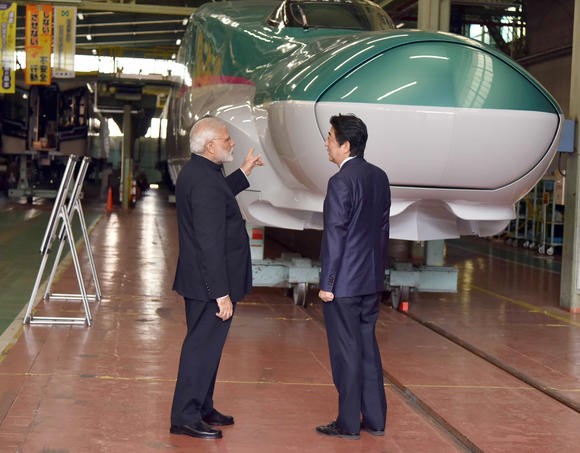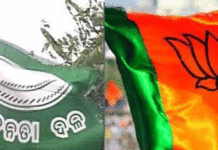The high speed train deal has benefited Japan no end as it found in India a buyer of its overpriced technology. A significant chunk of the loan from Japan will go back to Japan as the price for the technology. Several Japanese companies might be involved with the project to take a lion’s share of the investment pie.
When Prime Minister Narendra Modi and his Japanese counterpart Shinzo Abe laid the foundation for India’s first bullet train project at Ahmedabad on September 14, they were visibly euphoric.
However the country was clearly divided on the Rs.1.10 lakh crore project. The first group, which was as euphoric as Modi, hailed it as a big leap forward in technology to modernise an outdated rail network in the country. The second group, on the other hand, said the expensive bullet train project heavily funded by Japanese loan was not at all a priority when the railway tracks across the country, which had been causing several accidents and deaths, needed urgent investment for large scale repair or renovation. In the raging debate over Modi’s pet project, there were more takers for the arguments by the second group.
While inaugurating the project, Modi said that the bullet train is as good as free of cost while referring to the Rs.88,000 crore Japanese loan to be repaid over 50 years at an interest rate of just 0.1%. Nothing is free, especially loan however soft it may be.
There are three reasons why it is not at all free.
Firstly, the deal has benefited Japan no end as it found in India a buyer of its overpriced technology. A significant chunk of the loan from Japan will go back to Japan as the price for the technology.
Secondly, several Japanese companies might be involved with the project to take a lion’s share of the investment pie. One biggie from Japan, Kawasaki Heavy, is already in the picture along with BHEL.
Thirdly, due to depreciation of rupee against Japanese yen over five decades, India might have to pay Japan much more than the loan it has taken. Noted economic journalist M.K. Venu calculated that as the average inflation rate in India is 3% over the next two decades against Japan’s zero inflation, the rupee has to depreciate 3% every year because the rupee’s value is eroding by 3% as against no erosion in the yen. “So the rupee is bound to weaken by over 60% in two decades. This means that on a loan of Rs.88,000 crore, the repayment, in rupee term goes up to more than Rs.1,50,000 crore at the end of 20 years,” he wrote in thewire.in and Business Standard.
Another apprehension about bullet train’s viability is that it has not succeeded everywhere in the world. Take for instance the case of Taiwan, which adopted the same Japanese technology as India has now. It started the bullet train in 2007 with a project cost of $14.3 billion. By 2014, the project had incurred a cumulative loss of $1.5 billion. The Taiwanese government then bailed it out by infusing another $1 billion of government fund, which came from taxing the common public. Such a scenario in India after seven years may weaken the economy and put an extra burden on the people already paying taxes through their nose.
It is however not about investment and return but priority at a time train accidents across the country are dime a dozen.
As against 1.6 lakh commuters who are projected to travel in the bullet train annually, 8.10 billion people travel in trains that run on a network of 65,000 km long tracks. There are no sufficient funds to repair the fragile tracks in a big way. There are not enough trains for people who jostle for space in reserved compartments and travel like sheep and goats in general compartments. The budgetary expenditure for the Railways for 2017-18 is Rs.1.30 lakh crore, just a little higher than the budget of the bullet train along a 508 km long track between Mumbai and Ahmedabad.
According to official figures, 18 persons are killed every month due to train accidents. Train derailments in 2016-17 have caused the highest number of deaths in a decade in the country. A total of 333 persons were killed due to 206 accidents in the last three years after the Modi government came to power – also highest in the decade that has seen over 2,500 deaths due to 1,394 accidents, 51% of them due to derailment.
Indian Railways fragile tracks, and old coaches and outdated signal system urgently need a complete overhauling to ensure safety to crores of people. The Railways needs all round modernisation and technological upgradation. And when the government overlooks the pressing needs of basic infrastructure that affects the majority of people and goes for an expensive corridor that many allege is meant for India’s super rich, it invites criticism.
In February last year, architect of Delhi Metro, E. Sreedharan, said that he was not in favour of bullet train at a time basic railway network needed reforms. The Indian Railways should first focus on improving the existing facilities, speed, infrastructure and comfort of common passengers. “Maybe after eight to 10 years, we may require a bullet train,” he was quoted as saying.
India’s ‘Metro Man’, who had an illustrious career in the Railways and building metro projects, definitely knew better.










































